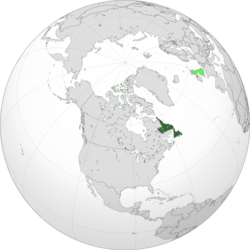
Back دومينيون نيوفاوندلاند Arabic Nyufaundlend Azerbaijani Дамініён Ньюфаўндленд Byelorussian Newfoundland (dominium) Czech Dominion Neufundland German Ντομίνιον της Νέας Γης Greek Dominio Novlando Esperanto Dominio de Terranova Spanish Ternuako Eremua Basque قلمرو نیوفاندلند Persian
Newfoundland | |||||||||||
|---|---|---|---|---|---|---|---|---|---|---|---|
| 1907–1949 | |||||||||||
| Motto: Quaerite prime regnum Dei (Latin) "Seek ye first the kingdom of God" | |||||||||||
| Anthem: "Ode to Newfoundland" | |||||||||||
 Map of the Dominion of Newfoundland | |||||||||||
| Status |
| ||||||||||
| Capital and largest city | St. John's | ||||||||||
| Official languages | English | ||||||||||
| Demonym(s) | Newfoundlander | ||||||||||
| Government | Responsible government | ||||||||||
| King | |||||||||||
• 1907–1910 (first) | Edward VII | ||||||||||
• 1936–1949 (last) | George VI | ||||||||||
| Governor | |||||||||||
• 1907–1909 (first) | Sir William MacGregor | ||||||||||
• 1946–1949 (last) | Sir Gordon Macdonald | ||||||||||
| Prime Minister | |||||||||||
• 1907–1910 (first) | Sir Robert Bond | ||||||||||
• 1932–1934 (last) | Frederick C. Alderdice | ||||||||||
| Legislature | General Assembly of Newfoundland | ||||||||||
| Legislative Council of Newfoundland | |||||||||||
| House of Assembly | |||||||||||
| Historical era | Early to mid-20th century | ||||||||||
• Semi-sovereign dominion | 26 September 1907 | ||||||||||
| 19 November 1926 | |||||||||||
| 16 February 1934 | |||||||||||
| 31 March 1949 | |||||||||||
| Area | |||||||||||
• Total | 405,212 km2 (156,453 sq mi) | ||||||||||
| Currency | Newfoundland dollar | ||||||||||
| |||||||||||
| Today part of | |||||||||||
*National holidays celebrated on 24 June, Discovery Day, and 26 September, Dominion Day. Patron saint John the Baptist. | |||||||||||
Newfoundland was a British dominion in eastern North America, today the modern Canadian province of Newfoundland and Labrador. It included the island of Newfoundland, and Labrador on the continental mainland. Newfoundland was one of the original dominions under the Balfour Declaration of 1926, and accordingly enjoyed a constitutional status equivalent to the other dominions of the time. Its dominion status was confirmed by the Statute of Westminster, 1931, although the statute was not otherwise applicable to Newfoundland.
In 1934, Newfoundland became the only dominion to give up its self-governing status, which ended 79 years of self-government.[1] The abolition of self-government came about because of a crisis in Newfoundland's public finances in 1932. Newfoundland had accumulated a significant amount of debt by building a railway across the island, which was completed in the 1890s, and by raising its own regiment during the First World War.[1] In November 1932, the government warned that Newfoundland would default on payments on the public debt.[1] The British government quickly established the Newfoundland Royal Commission to inquire into and report on the position.[1] The commission's report, published in October 1933, recommended that Newfoundland give up self-government temporarily and allow the United Kingdom to administer it by an appointed commission.[1]
The Newfoundland parliament accepted the recommendations; it then presented a petition to the King to ask for the suspension of the constitution and the appointment of commissioners to administer the government until the country became self-supporting again.[2] To enable compliance with the request, the British Parliament passed the Newfoundland Act, 1933, and on 16 February 1934, the British government appointed six commissioners, three from Newfoundland and three from the United Kingdom, with the governor as chairman.[2] The system of a six-member Commission of Government continued to govern Newfoundland until Newfoundland joined Canada in 1949 to become Canada's tenth province.[3]
- ^ a b c d e Hiller, J. K. (2002). "The Newfoundland Royal Commission, 1933 (The Amulree Commission)". Newfoundland and Labrador Heritage Web Site. Retrieved 29 December 2015.
- ^ a b Roberts-Wray 1966, p. 830.
- ^ British North America Act, 1949 (12, 13 & 14 G. 6, c. 22)


